Finding the perfect haircut for your little boy with straight fine hair can feel like searching for a needle in a haystack, but it doesn’t have to be overwhelming.
The right haircut can transform thin, delicate strands into a stylish, manageable look that makes both parents and toddlers happy.
When it comes to Best 33+ Baby Boys’ Haircuts for Straight Fine Hair, understanding texture, growth patterns, and age-appropriate styles becomes essential for achieving that adorable, fuss-free appearance.
This comprehensive guide walks you through dozens of cutting-edge options specifically designed for fine-haired baby boys, from classic cuts that add volume to modern styles that embrace natural texture.
Whether you’re preparing for your son’s first haircut or looking to refresh his current style, you’ll discover practical techniques, styling tips, and creative ideas that work specifically for delicate straight hair.
Each haircut option has been carefully selected to address common challenges like flat appearance, quick growth, and maintaining shape between salon visits, ensuring your little one always looks his absolute best.
Contents
- 1 1. The Classic Baby Buzz Cut
- 2 2. Textured Crop with Fringe
- 3 3. Side Part Classic
- 4 4. Short Layered All-Over
- 5 5. Baby Mohawk (Faux Hawk)
- 6 6. Tapered Sides with Textured Top
- 7 7. Shaggy Longer Style
- 8 8. Bowl Cut Modern Interpretation
- 9 9. Crew Cut Variation
- 10 10. Asymmetrical Fringe
- 11 11. Caesar Cut for Toddlers
- 12 12. Spiky Textured Top
- 13 13. Blunt Fringe with Short Back
- 14 14. Natural Tousled Look
- 15 15. Ivy League Cut
- 16 16. Disconnected Undercut
- 17 17. French Crop
- 18 18. Curly-Top Illusion Cut
- 19 19. Military High and Tight
- 20 20. Surfer Shag
- 21 21. Pompadour for Toddlers
- 22 22. Brush Up with Fade
- 23 23. Choppy Layers Throughout
- 24 24. Side Swept with Undercut
- 25 25. Messy Fringe Forward
- 26 26. Tapered Neckline Special
- 27 27. Angular Fringe Cut
- 28 28. Uniform Length Classic
- 29 29. Layered Side Part
- 30 30. Short Textured Quiff
- 31 31. Neat Temple Fade
- 32 32. Wispy Layered Ends
- 33 33. Combination Style (Multiple Techniques)
- 34 34. Extra Bonus: First Haircut Special Consideration
- 35 Maintenance Tips for Fine Straight Hair
- 36 Choosing the Right Stylist
- 37 Styling Products for Fine Baby Hair
- 38 Common Mistakes to Avoid
- 39 Age-Appropriate Style Considerations
- 40 Seasonal Haircut Adjustments
- 41 When Fine Hair Becomes Thicker
- 42 Photography Tips for Fine-Haired Babies
- 43 Dealing with Cowlicks and Growth Patterns
- 44 Budget-Friendly Maintenance Strategies
- 45 Health Considerations for Fine Hair
- 46 Cultural and Regional Considerations
- 47 Conclusion
1. The Classic Baby Buzz Cut
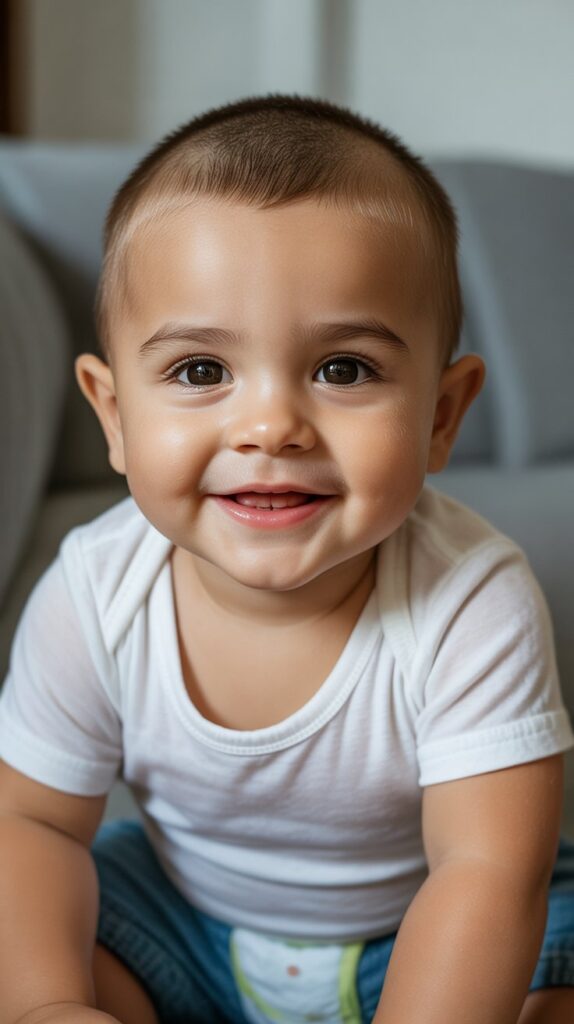
The buzz cut stands as one of the most practical and timeless options for baby boys with straight fine hair, offering minimal maintenance while creating an illusion of fuller coverage.
This ultra-short style works particularly well during warmer months and for active toddlers who don’t sit still during lengthy grooming sessions.
- The buzz cut eliminates the flat appearance that often plagues fine straight hair by keeping everything uniformly short and textured.
- Parents appreciate this style because it requires virtually no daily styling products or complicated morning routines.
- The uniform length typically ranges from 1/8 inch to 1/2 inch, depending on how short you want to go.
- This cut grows out evenly, meaning less frequent trips to the barber compared to styles with varying lengths.
- Fine hair actually looks thicker with a buzz cut because you’re seeing the hair density at its base rather than thin ends.
- The style works exceptionally well for babies with cowlicks or unusual growth patterns since everything is cut to the same length.
- Most barbers can complete a buzz cut in under 10 minutes, perfect for fidgety toddlers with limited patience.
2. Textured Crop with Fringe
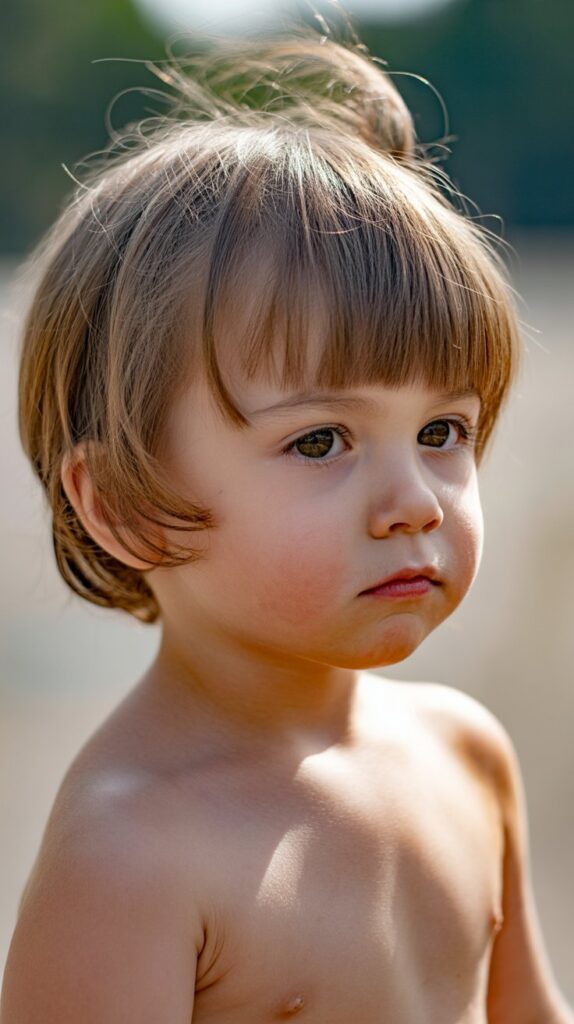
The textured crop with fringe has emerged as a modern favorite that adds dimension and movement to straight fine hair through strategic layering and cutting techniques.
This style creates visual interest while maintaining a youthful, age-appropriate appearance that grows out gracefully.
- The fringe component provides coverage for larger foreheads while adding a focal point that draws attention away from hair thinness.
- Texturizing techniques involve point cutting or using thinning shears to create varied lengths that prevent the flat look.
- This cut typically leaves 1-2 inches of length on top with slightly shorter sides, creating subtle contrast.
- The natural texture of straight hair works beautifully with this style because it falls into place without excessive styling.
- Parents can use a small amount of lightweight styling cream to enhance the texture on special occasions.
- The fringe can be styled forward, swept to the side, or left natural depending on your preference.
- This haircut grows out well over 4-6 weeks, maintaining its shape longer than many other options.
- The versatility allows for easy transitions as your child grows from baby to toddler to preschooler.
3. Side Part Classic
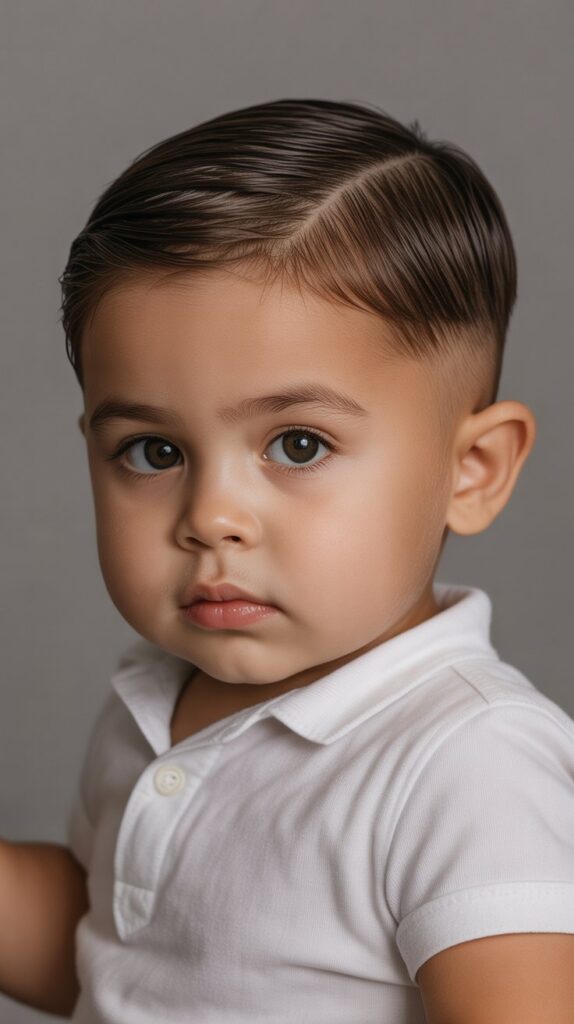
The side part classic brings a sophisticated, timeless elegance to baby boys’ hairstyles while cleverly addressing the volume challenges associated with fine straight hair.
This traditional approach has remained popular across generations because it flatters most face shapes and hair types.
- Creating a defined side part gives the illusion of more hair by directing strands in opposing directions.
- The style typically maintains 2-3 inches of length on top, allowing enough hair to work with while avoiding weighing down fine strands.
- Barbers usually cut the sides shorter (using clipper guards #3 or #4) to create contrast and make the top appear fuller.
- This cut requires minimal daily maintenance—simply comb through with fingers or a soft baby brush after bath time.
- A tiny amount of water-based styling product can help hold the part in place for photos or special events.
- The side part works exceptionally well for formal occasions like family photos, weddings, or religious ceremonies.
- Fine straight hair naturally falls into the parted style without fighting against natural curl patterns.
- As the child grows, this classic cut easily transitions into more mature versions of the same style.
4. Short Layered All-Over

Short layered cuts distributed evenly across the head create movement and dimension that fine straight hair desperately needs to avoid looking limp or flat.
This approach focuses on creating subtle variations in length that work together to produce fuller-looking coverage.
- Layering involves cutting hair at different lengths throughout the head rather than maintaining one uniform length.
- The technique prevents fine hair from clumping together, which often makes thinness more apparent.
- Most stylists keep the layers relatively close together (within 1/4 to 1/2 inch differences) to maintain a cohesive look.
- This style provides natural volume lift at the roots because shorter underlayers support longer top layers.
- The all-over approach means no dramatic differences between front, back, and sides, creating a balanced appearance.
- Parents find this cut easy to manage because it looks good whether styled or left completely natural.
- The layering helps hair dry faster after baths, reducing the time spent on grooming routines.
- This haircut works particularly well for babies transitioning from very thin baby hair to slightly thicker toddler hair.
5. Baby Mohawk (Faux Hawk)
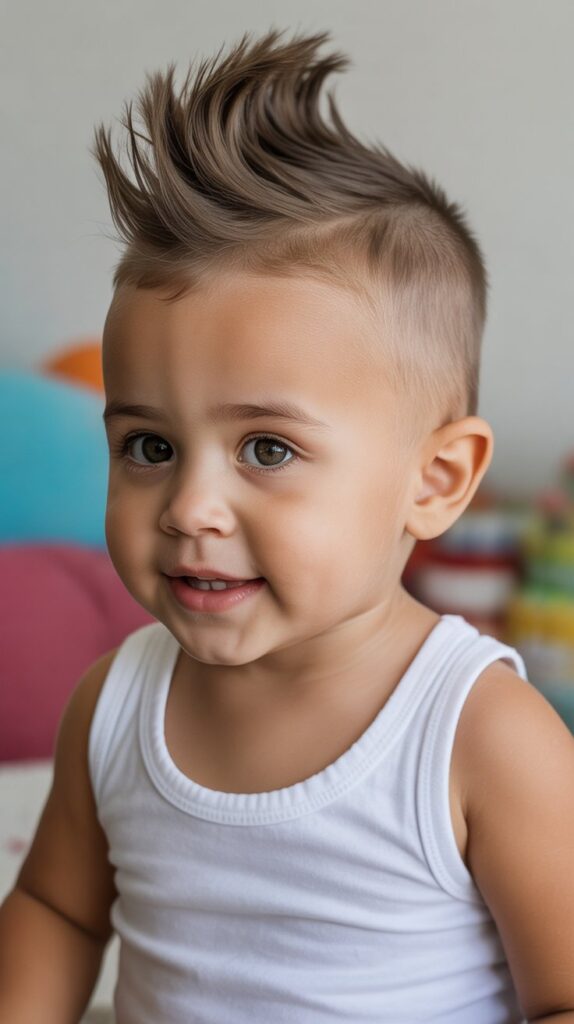
The baby mohawk or faux hawk offers a playful, trendy option that maximizes whatever volume exists in fine straight hair by concentrating length in the center strip.
This edgy-yet-cute style has become increasingly popular for fashion-forward parents wanting something beyond traditional cuts.
- Unlike adult mohawks, the baby version keeps everything soft and age-appropriate with gentle transitions.
- The center section typically maintains 1-2 inches of length while sides are cut short with clippers.
- Fine straight hair actually stands up more easily than thick coarse hair, making this style surprisingly achievable.
- A small amount of baby-safe gel or styling cream helps the center section stand upright for special occasions.
- The style can be worn “up” for events or simply left natural for everyday wear, offering versatility.
- Many parents choose this cut because it photographs exceptionally well and creates memorable baby photos.
- The shorter sides make the head appear more proportional, especially for babies with larger head sizes.
- This cut requires more frequent maintenance (every 3-4 weeks) to keep the contrast between center and sides sharp.
6. Tapered Sides with Textured Top
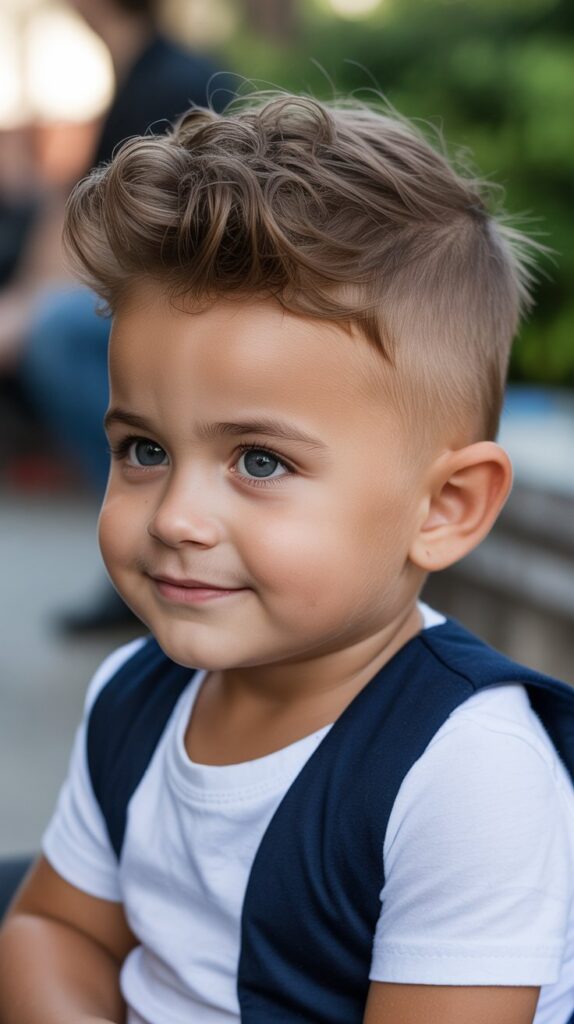
Tapered sides combined with a textured top represent a modern approach that addresses both style and the practical challenges of maintaining fine straight hair.
This contemporary cut creates visual interest through contrast while keeping maintenance requirements reasonable for busy parents.
- The taper gradually decreases hair length from the top of the head down to the neckline and around the ears.
- This graduated approach creates the illusion of denser hair on top by providing visual contrast against shorter sides.
- Texturizing the top section involves cutting techniques that create piece-y separation rather than blunt uniformity.
- The style works well for fine hair because it doesn’t require thick density to look intentional and complete.
- Parents can achieve a styled look by simply running fingers through damp hair after bath time.
- The taper keeps hair off the ears and neck, reducing irritation and the need for constant tucking.
- This cut typically lasts 4-5 weeks before requiring a trim, making it economical for families.
- The modern aesthetic appeals to younger parents looking for Instagram-worthy baby photos.
7. Shaggy Longer Style
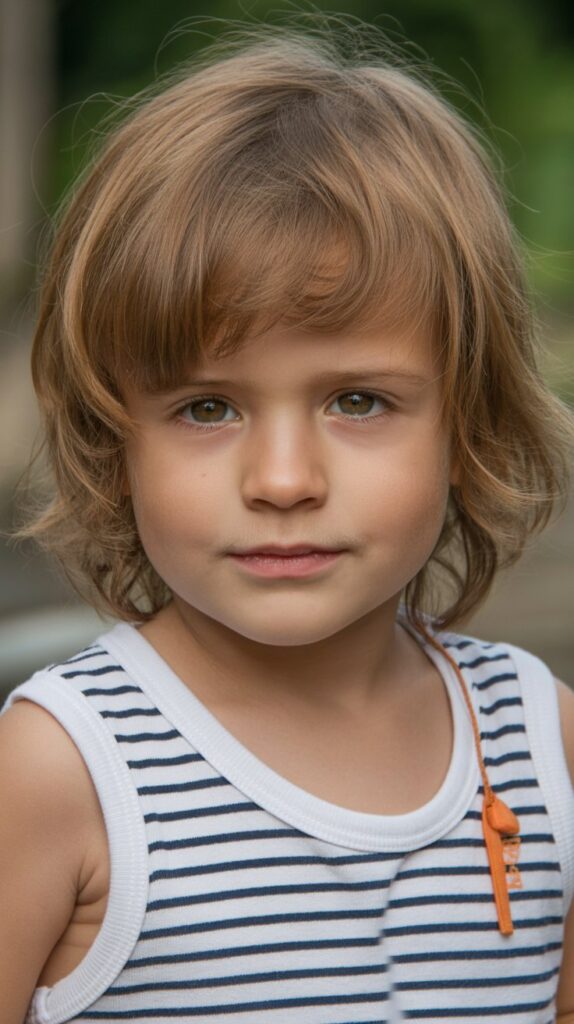
The shaggy longer style embraces natural texture and movement, working with fine straight hair rather than fighting against it to create an effortlessly cool, bohemian appearance.
This relaxed approach suits laid-back families who prefer less structured grooming routines.
- This style typically maintains 2-4 inches of length throughout, creating that coveted “beach hair” look.
- The shag incorporates layers that prevent fine hair from looking stringy or weighed down by its own length.
- Straight fine hair develops natural piece-y separation in longer styles, eliminating the need for styling products.
- The relaxed nature of this cut means it grows out gracefully without requiring frequent barber visits.
- Parents should use a detangling spray after baths to prevent knots in the longer lengths.
- This style works particularly well for babies with softer, slower-growing hair that takes time to achieve length.
- The shaggy look photographs beautifully with natural lighting and outdoor settings.
- Some parents prefer this style because it maintains that “baby” appearance longer as children grow.
8. Bowl Cut Modern Interpretation
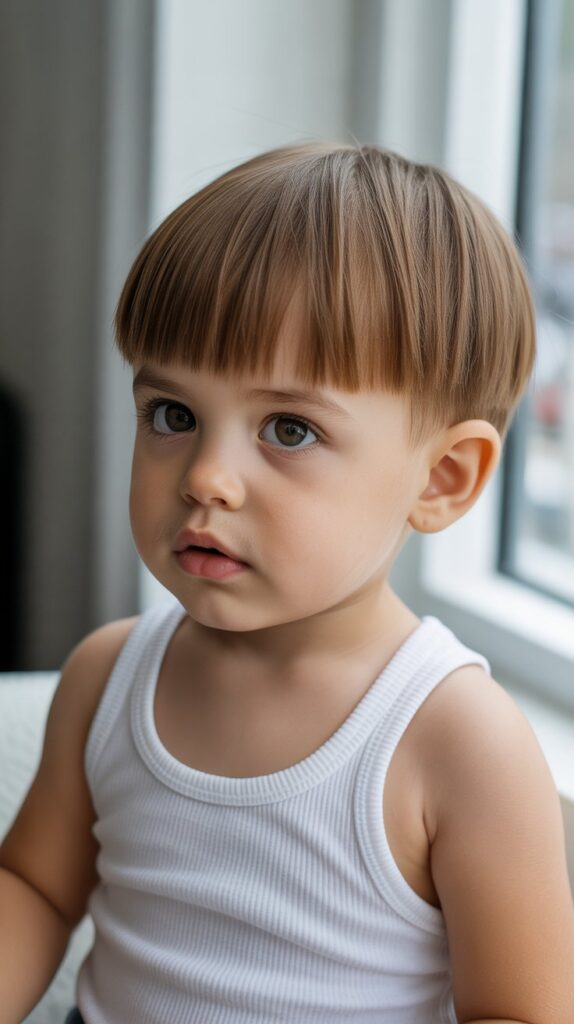
The modern bowl cut has evolved significantly from its 1990s predecessor, now featuring softer edges and subtle texturing that flatters fine straight hair while maintaining that distinctive rounded silhouette.
This updated version combines nostalgia with contemporary styling techniques.
- Today’s bowl cut features graduated layers rather than the harsh blunt line of traditional versions.
- The rounded shape actually makes fine hair appear fuller by creating consistent coverage all around the head.
- Stylists typically leave 2-3 inches of length while maintaining that characteristic curved outline.
- The cut works exceptionally well for babies with naturally straight hair that falls uniformly.
- Modern variations include subtle texturing on the ends to prevent that overly perfect, dated appearance.
- This style requires minimal daily maintenance since it naturally falls into its intended shape.
- The bowl cut suits round and oval face shapes particularly well, complementing natural facial proportions.
- Parents appreciate how this cut frames the face while keeping hair out of eyes and off the neck.
9. Crew Cut Variation

The crew cut variation offers a military-inspired aesthetic that’s been softened for baby boys, providing a neat, tidy appearance that makes fine straight hair look intentionally styled rather than thin.
This practical option balances professionalism with age-appropriate cuteness.
- The crew cut typically features very short sides (clipper guard #2 or #3) with a slightly longer top section.
- The top gradually decreases in length from front to back, creating a subtle slope that adds dimension.
- Fine hair benefits from this style because the short length prevents the limp appearance of longer styles.
- The structured nature of this cut makes it ideal for formal events and family portraits.
- Maintenance involves a simple trim every 3-4 weeks to maintain the graduated shape.
- This style keeps hair completely off the forehead, preventing irritation and keeping little faces clear.
- The crew cut works well for active babies who play hard and get messy during outdoor activities.
- Parents find this cut practical for swimming since it dries quickly and doesn’t require post-pool styling.
10. Asymmetrical Fringe

The asymmetrical fringe introduces an artistic, contemporary element to baby boys’ haircuts while cleverly addressing the volume limitations of fine straight hair through strategic placement.
This fashion-forward option appeals to parents seeking unique, memorable styles.
- The asymmetry involves cutting the fringe longer on one side, creating a diagonal line across the forehead.
- This technique draws the eye along the angle rather than focusing on hair density or thickness.
- The longer side typically extends to eyebrow length while the shorter side sits above the brow.
- Fine straight hair naturally falls into this style without requiring products or complicated styling routines.
- The asymmetrical element adds movement and interest that might otherwise be lacking in very fine hair.
- This cut photographs exceptionally well from multiple angles, offering variety in pictures.
- Parents can easily maintain the style between cuts by trimming the fringe when it grows into eyes.
- The back and sides usually stay shorter to create contrast and prevent the overall look from becoming too heavy.
11. Caesar Cut for Toddlers
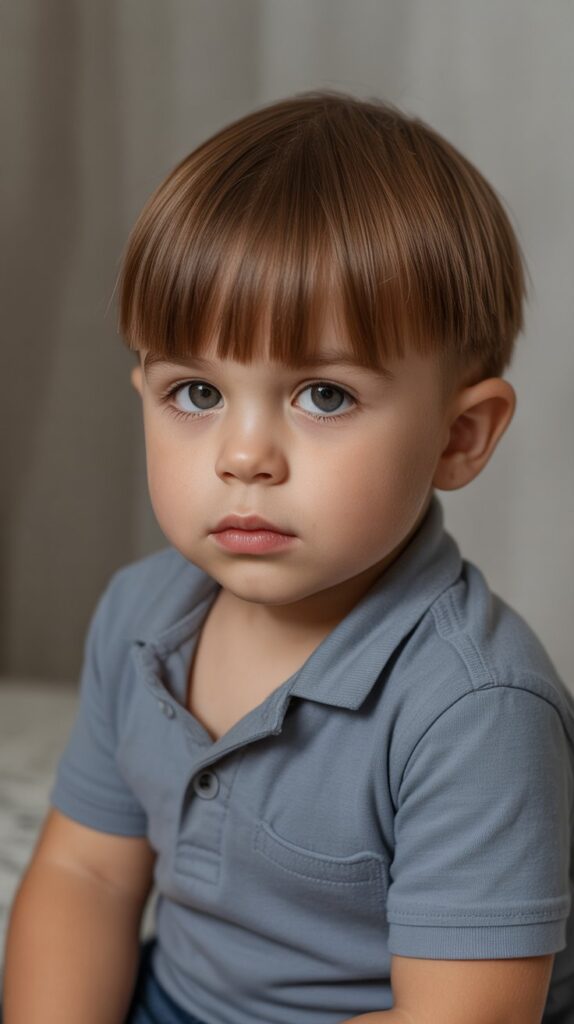
The Caesar cut brings Roman-inspired sophistication to modern baby hairstyles, featuring a short horizontal fringe and uniform length that works brilliantly with fine straight hair texture.
This historically-rooted style has found new popularity among contemporary parents.
- The defining characteristic is the short, horizontally-cut fringe that extends straight across the forehead.
- The entire cut typically maintains 1-2 inches of length, creating consistency and preventing thinness from showing.
- Fine straight hair naturally complements this style because it falls forward into the intended position.
- The Caesar cut provides excellent coverage for babies with slightly larger foreheads or receding baby hairlines.
- This low-maintenance style requires no daily styling beyond a quick comb-through after washing.
- The uniform length means the cut grows out evenly, extending the time between necessary trims.
- Many stylists recommend this cut for first haircuts because it’s quick, simple, and forgiving.
- The classic nature of this style means it never looks dated in family photos years later.
12. Spiky Textured Top

The spiky textured top creates an energetic, fun appearance that maximizes volume in fine straight hair through strategic cutting and optional styling techniques.
This playful option suits adventurous families wanting their baby boy to stand out.
- Creating spikes involves cutting the top section to 1-2 inches and using texturizing techniques for piece-y separation.
- Fine straight hair actually holds spikes better than heavy thick hair because it’s lighter and easier to manipulate.
- Parents can achieve this look naturally or use a tiny amount of styling product for extra hold during events.
- The shorter sides (usually clipper guard #3 or #4) create contrast that makes the spiky top more dramatic.
- This style works particularly well for babies with naturally upright growth patterns that fight against flat styling.
- The spiky texture adds inches of perceived height, making the head appear more proportional to the body.
- Many parents choose this cut because it captures that fun, carefree essence of childhood.
- The style requires moderate maintenance with trims every 3-4 weeks to maintain the proper length ratio.
13. Blunt Fringe with Short Back
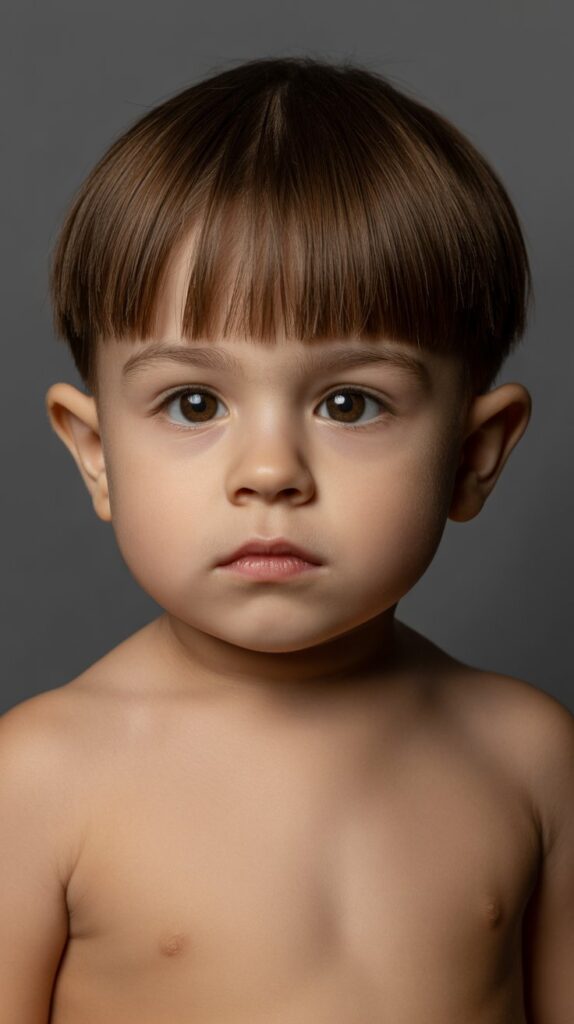
The blunt fringe with short back combination creates a distinctive silhouette that’s both practical and stylish for fine straight hair.
This structured approach offers clear definition while maintaining simplicity in daily care.
- The blunt fringe is cut straight across, typically at eyebrow length, creating a strong horizontal line.
- Keeping the back and sides very short (often with clippers) provides maximum contrast with the fringe.
- Fine hair benefits from the blunt cut because it creates the appearance of density at the fringe line.
- This style prevents hair from falling into eyes while maintaining enough length for visual interest.
- The dramatic difference between front and back makes this cut instantly recognizable and memorable.
- Parents find this style practical because it combines the coverage of a fringe with the low maintenance of short sides.
- The geometric nature of this cut works well for fashion-forward families wanting editorial-quality photos.
- Stylists can complete this cut quickly, making it ideal for impatient toddlers with short attention spans.
14. Natural Tousled Look
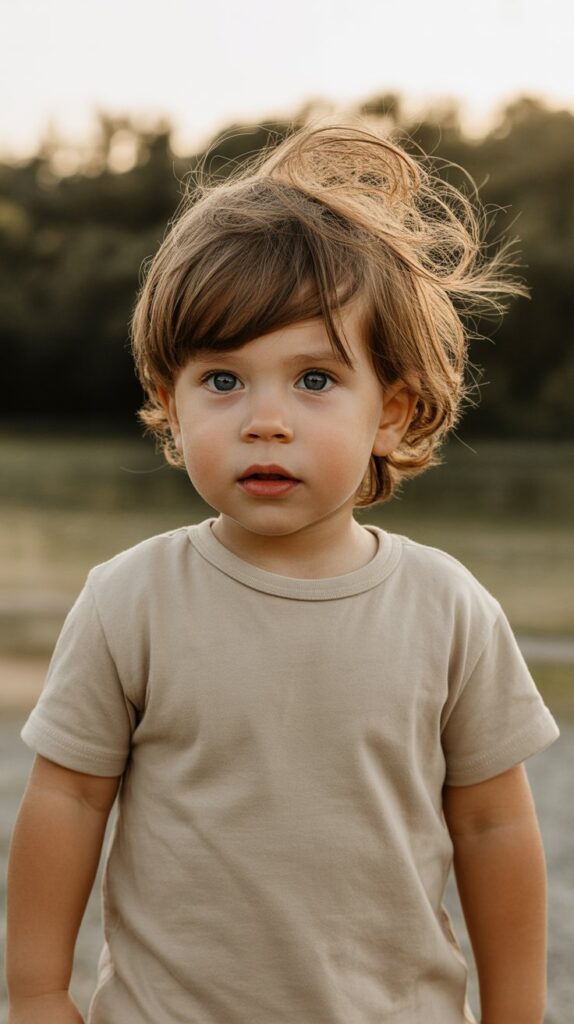
The natural tousled look embraces the inherent characteristics of fine straight hair, working with its tendency to separate and move rather than forcing it into structured styles.
This effortless approach celebrates authenticity and reduces grooming stress.
- This style involves cutting to 2-3 inches throughout while incorporating subtle layers for movement.
- The tousled aesthetic means imperfection becomes part of the charm rather than something to correct.
- Fine hair naturally achieves this look without products because it doesn’t have the weight to stay perfectly in place.
- Parents love this option because it looks intentionally styled even when hair is simply air-dried after washing.
- The natural approach works beautifully for lifestyle photography and candid family moments.
- This cut grows out gracefully over 6-8 weeks, making it economical for budget-conscious families.
- The tousled style suits active babies whose hair gets messed up during play anyway.
- Many experts recommend this approach for babies transitioning from infant hair to toddler hair texture.
15. Ivy League Cut
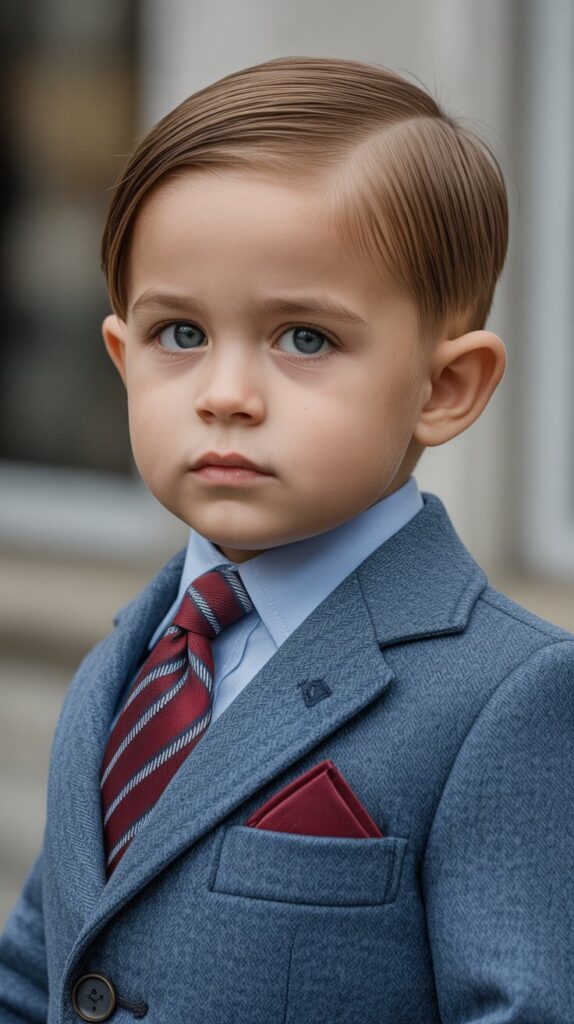
The Ivy League cut represents a slightly longer variation of the crew cut, offering a preppy, refined appearance that adds sophistication to fine straight hair.
This collegiate-inspired style balances formality with youth-appropriate charm.
- The Ivy League features short tapered sides with enough length on top (2-3 inches) to comb and part.
- This extended length allows for styling versatility while still maintaining the cut’s structured nature.
- Fine straight hair works exceptionally well because it naturally lies flat and cooperates with combing.
- The style can be parted on either side or brushed forward depending on preference and face shape.
- This cut provides excellent coverage for various head shapes while maintaining a polished appearance.
- Parents often choose this style for formal occasions, school photos, and professional family portraits.
- The Ivy League grows out more gracefully than very short cuts, extending time between necessary trims.
- A small amount of lightweight pomade can enhance the polished look for special events.
16. Disconnected Undercut

The disconnected undercut creates dramatic contrast through an abrupt transition between very short sides and a longer top section, making a bold statement that draws attention away from hair thinness.
This edgy contemporary style has gained popularity among fashion-conscious parents.
- The “disconnected” term refers to the lack of gradual blending—sides go from very short to long top immediately.
- This dramatic contrast creates the illusion of significantly more hair on top than actually exists.
- Fine straight hair benefits because the eye focuses on the style’s architecture rather than hair density.
- The top section typically maintains 2-4 inches, allowing for various styling options including slicked back or messy.
- This cut requires more frequent maintenance (every 2-3 weeks) to keep the sides trimmed and the contrast sharp.
- Parents can style the top section multiple ways depending on the occasion, offering versatility.
- The modern aesthetic makes this cut extremely popular on social media and parenting blogs.
- Professional barbers recommend this style for older babies (18+ months) who can sit still during precise cutting.
17. French Crop
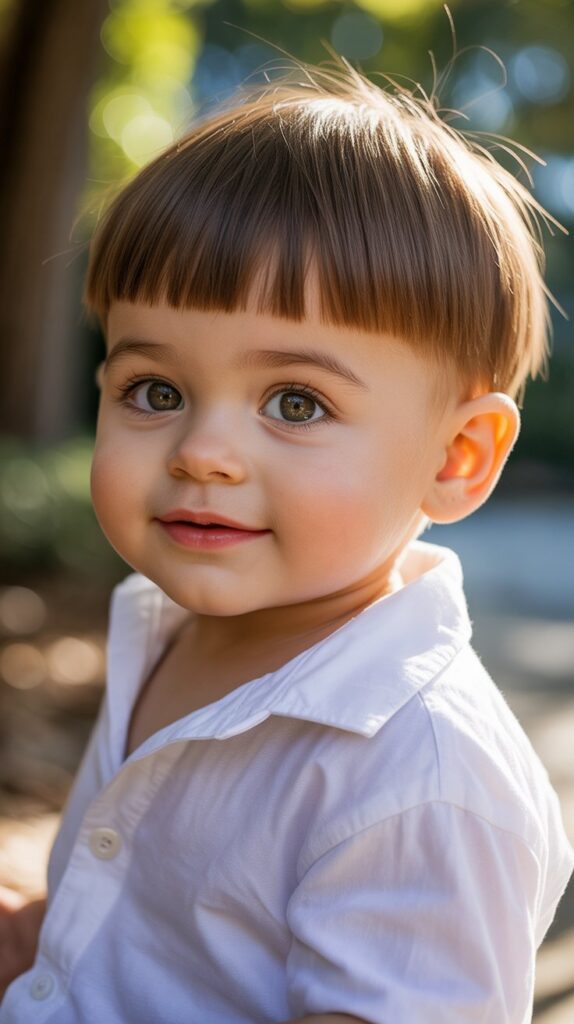
The French crop offers a European-inspired sophistication featuring a short textured top with a distinctively cut fringe that flatters fine straight hair beautifully.
This continental style has crossed the Atlantic to become a favorite among American families.
- The French crop features a blunt or slightly textured fringe that typically sits just above the eyebrows.
- The top remains short (1-2 inches) and textured, creating a low-maintenance yet stylish appearance.
- Sides and back are faded or tapered, providing the contrast that makes fine hair appear fuller.
- This style works perfectly for straight fine hair because it requires no natural volume or thickness to look complete.
- The short length prevents fine hair from looking limp or flat, a common problem with longer styles.
- Parents appreciate the minimal daily maintenance—simply run fingers through after washing and go.
- The French crop suits oval, round, and heart-shaped faces particularly well.
- This cut has become increasingly popular in children’s fashion photography and editorial spreads.
18. Curly-Top Illusion Cut

The curly-top illusion cut uses strategic texturizing and cutting angles to create wave-like movement in naturally straight fine hair, producing unexpected dimension and interest.
This creative approach transforms the perception of texture through skilled technique.
- Stylists achieve this illusion through point-cutting, razor-cutting, or heavy texturizing with thinning shears.
- The technique creates uneven lengths that stack and interact, producing movement that mimics natural wave patterns.
- Fine hair responds particularly well to these texturizing methods because it’s easier to manipulate than coarse hair.
- The resulting style appears to have more body and dimension than the natural hair texture would suggest.
- This cut requires an experienced stylist familiar with working specifically with fine hair textures.
- Parents can enhance the textured appearance with a tiny amount of sea salt spray for special occasions.
- The illusion works best with 2-3 inches of length on top, providing enough hair to create the layered effect.
- This creative option appeals to families wanting something unique that showcases their stylist’s artistry.
19. Military High and Tight
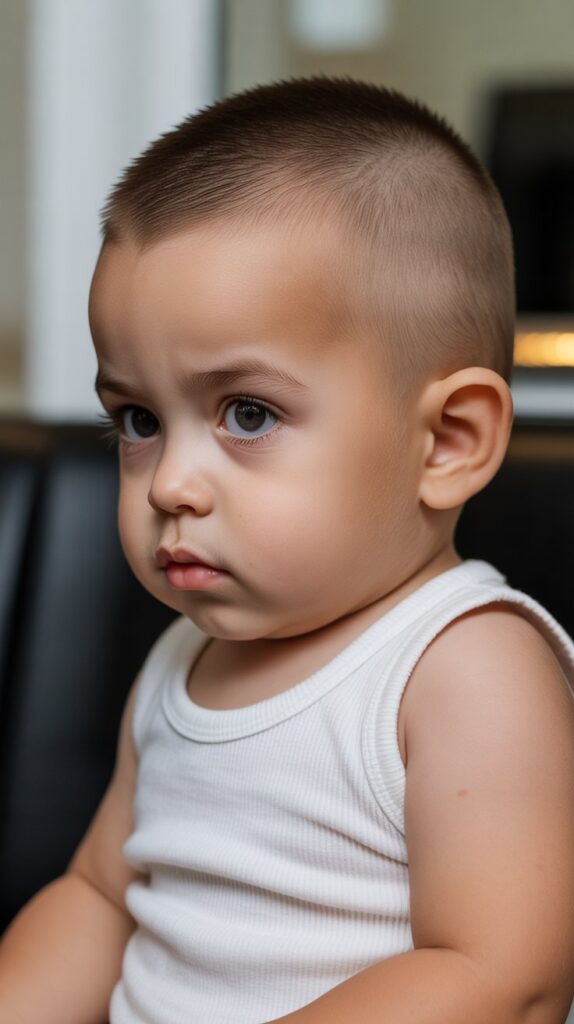
The military high and tight brings precision and discipline to baby boys’ hairstyles through its distinctive extremely short sides with a slightly longer strip on top.
This no-nonsense approach maximizes the appearance of fine straight hair while minimizing maintenance.
- The “high” refers to how far up the sides the very short cut extends, usually to the temple area.
- The “tight” indicates how close the sides are buzzed, often using a #1 or #2 clipper guard.
- The top maintains 1-2 inches of length, creating a distinct strip or rectangular shape of longer hair.
- Fine straight hair looks intentionally styled rather than thin because the cut’s architecture provides structure.
- This style requires minimal daily maintenance but needs frequent trims (every 2-3 weeks) to maintain shape.
- The military precision appeals to families with service backgrounds or those preferring structured aesthetics.
- This cut keeps babies extremely cool during hot weather and requires no styling products.
- The high contrast makes this one of the most dramatic and recognizable baby boy haircuts available.
20. Surfer Shag

The surfer shag embraces a relaxed, beachy aesthetic that works beautifully with fine straight hair’s natural tendency to separate and move freely.
This laid-back style captures the essence of coastal cool while remaining practical for everyday life.
- This style typically maintains 3-4 inches of length with heavy layering throughout for movement and dimension.
- The shag incorporates shorter layers underneath with longer pieces on top, creating that signature piece-y texture.
- Fine straight hair naturally achieves the desired separation without requiring salt spray or styling products.
- The longer length works for parents wanting to grow out their baby’s hair while maintaining a styled appearance.
- This cut grows out exceptionally well over 6-8 weeks, making it economical for busy families.
- The surfer shag suits active, outdoorsy families whose lifestyle aligns with the aesthetic.
- Parents can leave this style completely natural or add minimal product for enhanced texture on special occasions.
- This cut photographs beautifully in outdoor settings with natural lighting and casual clothing.
21. Pompadour for Toddlers
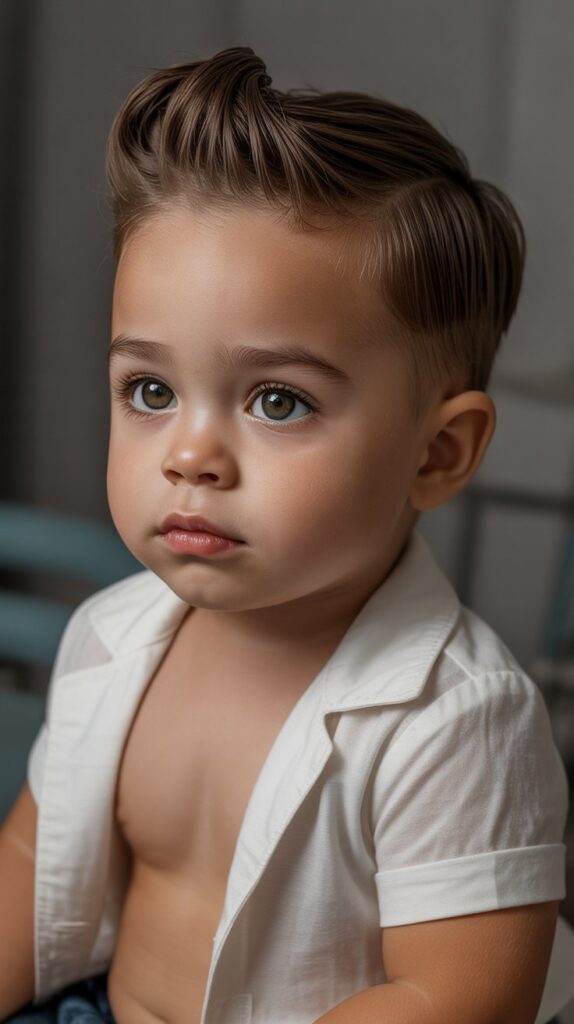
The toddler pompadour adapts the classic vintage style for young children, creating height and volume at the front that cleverly disguises the fine texture of straight hair.
This retro-modern hybrid has become surprisingly popular for fashion-forward baby boys.
- The pompadour features hair swept upward and backward at the front, creating volume and height.
- Sides are cut significantly shorter to emphasize the height achieved in the front section.
- Fine straight hair actually works well for baby pompadours because it’s easier to style upward than heavy hair.
- This style requires a small amount of baby-safe pomade or styling cream to achieve and maintain the lift.
- The pompadour creates the illusion of thickness by stacking hair upward rather than letting it lie flat.
- Parents typically style this look for special occasions rather than maintaining it daily.
- The cut can be worn styled or left natural, offering versatility depending on the situation.
- This distinctive style creates memorable photos and showcases personality in baby portraits.
22. Brush Up with Fade
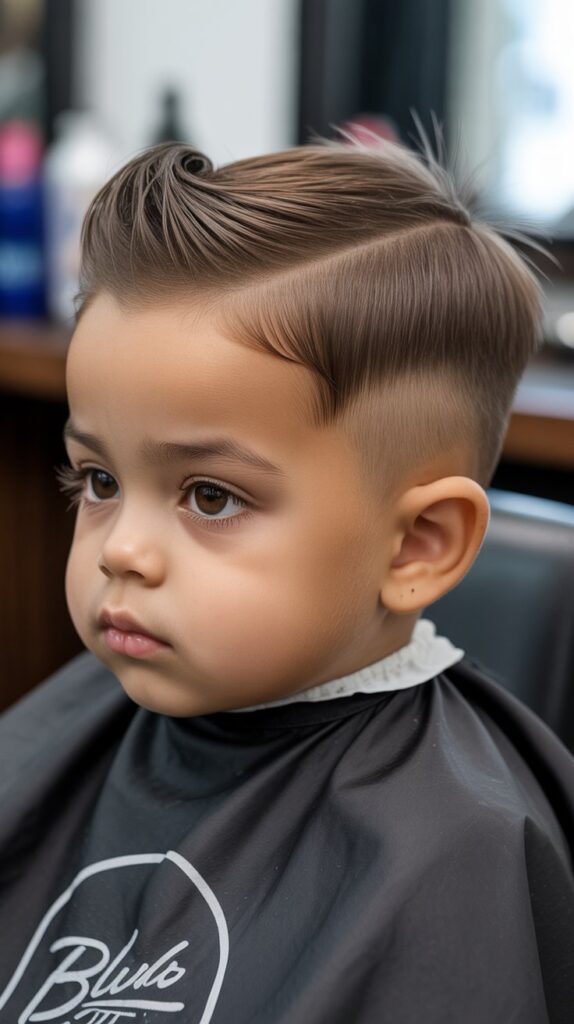
The brush up with fade combines upward-styled hair with gradually faded sides, creating a modern athletic appearance that maximizes volume in fine straight hair.
This contemporary style has become extremely popular in urban barbershops.
- The brush up involves cutting the top to 2-3 inches and styling it upward and slightly backward.
- The fade gradually transitions from very short at the bottom to longer at the top, creating smooth blending.
- Fine hair stands up more easily than thick coarse hair, making this style surprisingly achievable for babies.
- The upward direction creates instant volume and makes hair appear significantly thicker than it is.
- This style requires daily styling with a small amount of product to maintain the upward direction.
- The fade keeps the sides and back extremely neat and low-maintenance despite the styled top.
- Professional barbers can create various fade types (low, mid, or high) depending on parental preference.
- This cut requires maintenance every 2-3 weeks to keep the fade fresh and the proportions correct.
23. Choppy Layers Throughout

Choppy layers throughout create intentional texture and movement that transforms fine straight hair from limp to lively through strategic cutting techniques.
This modern approach embraces imperfection as a design element rather than something to hide.
- Choppy layers involve cutting hair at varying lengths with deliberate irregularity rather than smooth blending.
- This technique creates piece-y separation that makes fine hair appear to have more body and texture.
- The style typically maintains 2-3 inches of length throughout, providing enough hair to showcase the layering.
- Fine straight hair naturally falls into the choppy style because it doesn’t have the weight to clump together.
- Parents can achieve a styled look by simply tousling hair with fingers after washing—no products needed.
- The intentionally messy appearance means the cut always looks “done” even when hair is slightly grown out.
- This style works particularly well for babies with multiple cowlicks or difficult growth patterns.
- The choppy aesthetic photographs beautifully, capturing movement and personality in images.
24. Side Swept with Undercut

The side swept with undercut combines directional styling with dramatic contrast, creating a sophisticated yet youthful appearance that flatters fine straight hair beautifully.
This hybrid style offers the best of multiple cutting techniques.
- The top section maintains 2-4 inches of length, styled or naturally falling to one side.
- The undercut features very short (often buzzed) sides and back, creating maximum contrast.
- Fine straight hair naturally falls to the side without fighting the intended direction, making styling easy.
- The side sweep creates diagonal lines that draw the eye across rather than focusing on hair density.
- Parents can enhance the side sweep with a tiny amount of lightweight product for special occasions.
- This style works for both formal and casual settings, offering exceptional versatility.
- The undercut portion requires frequent maintenance (every 2-3 weeks) to maintain the sharp contrast.
- This modern cut appeals to parents wanting a contemporary style that still looks age-appropriate.
25. Messy Fringe Forward

The messy fringe forward embraces natural texture and relaxed styling, creating an effortlessly cool appearance that works with fine straight hair rather than against it.
This casual approach has gained popularity among parents favoring low-maintenance options.
- This style features 2-3 inches of length falling forward toward the forehead with intentional tousled texture.
- The messy element means imperfection is built into the design, eliminating stress about perfect styling.
- Fine straight hair naturally achieves the piece-y separation that makes this look work without products.
- The forward direction provides coverage for larger foreheads while maintaining a youthful appearance.
- Parents love this style because it looks good whether hair is freshly washed or a few days past washing.
- The fringe keeps hair out of eyes while still providing enough length for visual interest.
- This cut grows out gracefully over 6-8 weeks, making it economical for budget-conscious families.
- The casual aesthetic suits active, playful babies whose lifestyle includes lots of outdoor adventures.
26. Tapered Neckline Special

The tapered neckline special focuses specifically on creating clean, professional edges at the back of the neck while maintaining appropriate length elsewhere.
This detail-oriented approach elevates any haircut through precision finishing.
- The taper at the neckline gradually fades hair to skin, creating a polished finished look.
- This technique prevents the “grown out” appearance that happens when neckline hair becomes shaggy.
- Fine straight hair benefits from this precision because it shows the intentional nature of the cut.
- The tapered neckline works with any top style—from long to short, structured to messy.
- Professional barbers use clippers without guards and careful technique to create the graduated taper.
- This detail extends the life of the overall haircut by maintaining neatness longer between trims.
- Parents appreciate how this finishing touch makes even simple cuts look professionally done.
- The tapered neckline is especially important for special occasions and formal events when appearance matters most.
27. Angular Fringe Cut

The angular fringe cut features a deliberately diagonal line across the forehead, creating dynamic visual interest that draws attention away from hair density concerns.
This geometric approach adds architectural elements to soft baby features.
- The angular fringe typically starts shorter on one side and extends longer toward the opposite side.
- This diagonal line creates movement and direction that makes static straight hair more visually interesting.
- Fine hair actually showcases the angular line better than thick hair because the cut’s precision remains visible.
- The angle typically runs from temple height on one side to eyebrow level on the other.
- This style works particularly well for asymmetrical face shapes, providing visual balance.
- Parents can style the fringe across the forehead or sweep it to one side for different looks.
- The angular element makes this cut instantly recognizable and memorable in photos.
- Stylists recommend this cut for parents wanting something artistic that stands out from traditional options.
28. Uniform Length Classic
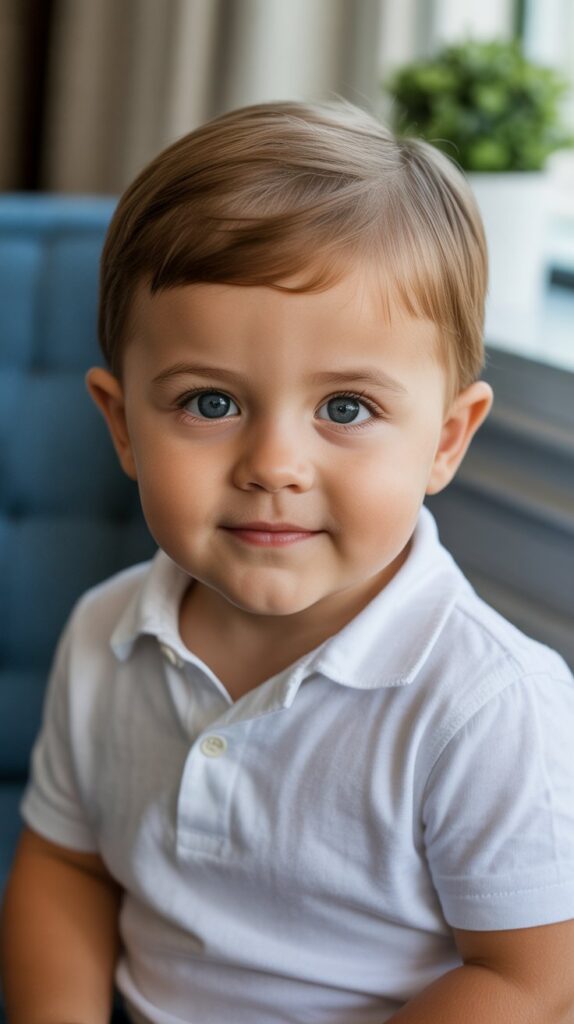
The uniform length classic maintains the same length throughout the entire head, creating simplicity and ease that works perfectly for fine straight hair.
This straightforward approach prioritizes practicality while maintaining a neat, intentional appearance.
- This style typically maintains 1-2 inches of consistent length from front to back, top to sides.
- The uniform approach eliminates any flat areas because there’s no length contrast to create shadows.
- Fine hair looks its best at moderate uniform lengths that aren’t too short or too long.
- Parents appreciate this cut because it requires minimal styling—just comb through after washing.
- The consistent length means the cut grows out evenly, extending time between necessary trims.
- This style works for babies of all ages, from first haircut through preschool years.
- The classic nature ensures the cut never looks dated in family photos years later.
- Many pediatric stylists recommend this as a first haircut because it’s quick, simple, and forgiving.
29. Layered Side Part
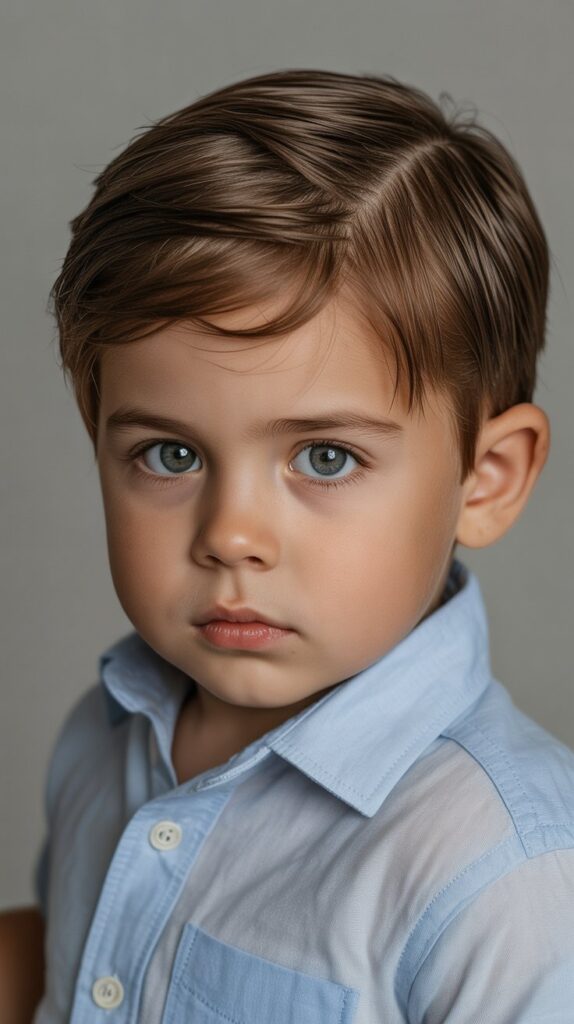
The layered side part combines the classic sophistication of a traditional part with modern layering techniques that add dimension to fine straight hair.
This hybrid approach offers timeless appeal with contemporary functionality.
- The side part provides structure and direction while layers throughout add movement and prevent flatness.
- The layers are typically cut at subtle intervals (1/4 to 1/2 inch differences) to maintain cohesion while adding dimension.
- Fine straight hair benefits from this combination because the part creates organization while layers prevent limpness.
- The style typically maintains 2-3 inches on top, allowing enough length to properly showcase both the part and layers.
- Parents can comb the part into place after washing or let it fall naturally for a more relaxed look.
- This cut works exceptionally well for oval and heart-shaped faces, complementing natural proportions.
- The layering prevents the flat, one-dimensional appearance that often plagues fine hair with traditional side parts.
- This versatile style transitions seamlessly from casual daily wear to formal occasions with minimal adjustment.
30. Short Textured Quiff

The short textured quiff brings rock-and-roll attitude to baby boys’ hairstyles while cleverly maximizing volume in fine straight hair through upward styling and strategic length placement.
This modern classic has become a staple in contemporary children’s salons.
- The quiff features hair styled upward and backward at the front, creating height without excessive length.
- This style typically maintains 2-3 inches at the front, gradually decreasing toward the crown.
- Fine straight hair actually holds a quiff shape well because it lacks the weight that pulls down thicker hair.
- The upward direction instantly creates the illusion of more volume and thickness than actually exists.
- Parents can style this look with a small amount of baby-safe styling cream for lasting hold.
- The textured element involves point-cutting or using texturizing shears to create piece-y separation.
- Sides are usually kept shorter (clipper guard #3 or #4) to emphasize the height achieved on top.
- This cut requires daily styling but only takes 1-2 minutes with damp hair after washing.
31. Neat Temple Fade
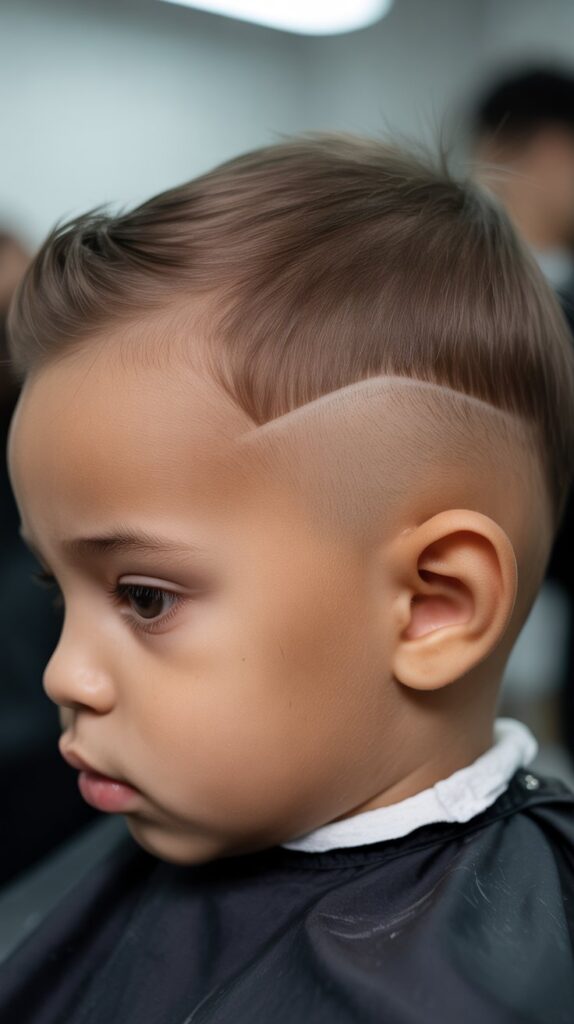
The neat temple fade focuses specifically on creating clean, graduated fading at the temple areas while maintaining versatility with the rest of the haircut.
This detail-oriented technique adds professional polish to any style.
- The temple fade gradually transitions from very short hair at the temples to longer hair moving upward and backward.
- This technique creates clean lines around the face, framing features attractively.
- Fine straight hair showcases temple fades beautifully because the precision work remains visible without thick hair obscuring it.
- The fade can be low (starting just above the ear), mid (starting at temple level), or high (starting well above temples).
- This specialized technique requires an experienced barber familiar with precision clipper work.
- The temple fade keeps hair off the face and ears, reducing irritation for sensitive babies.
- This detail work elevates even simple cuts, making them appear more sophisticated and intentional.
- Temple fades require maintenance every 2-3 weeks to keep the gradient smooth and defined.
32. Wispy Layered Ends

Wispy layered ends create soft, feathered texture at the tips of hair, producing a gentle, natural appearance that embraces rather than fights the delicate nature of fine straight hair.
This finishing technique adds refinement without harsh lines.
- This technique involves point-cutting or razor-cutting the very ends of hair to create soft, thin tips.
- The wispy effect prevents the blunt, heavy appearance that can make fine hair look even thinner.
- Fine straight hair naturally lends itself to this technique because it easily separates into delicate pieces.
- The layered ends create movement as hair responds to air and motion rather than hanging heavily.
- This approach works with various lengths from 2-4 inches, adding softness to multiple base styles.
- Parents appreciate how this finishing touch makes hair look naturally healthy and well-maintained.
- The wispy ends grow out gracefully without creating harsh demarcation lines as hair lengthens.
- This technique particularly suits babies with very fine, baby-soft hair that hasn’t yet coarsened.
33. Combination Style (Multiple Techniques)
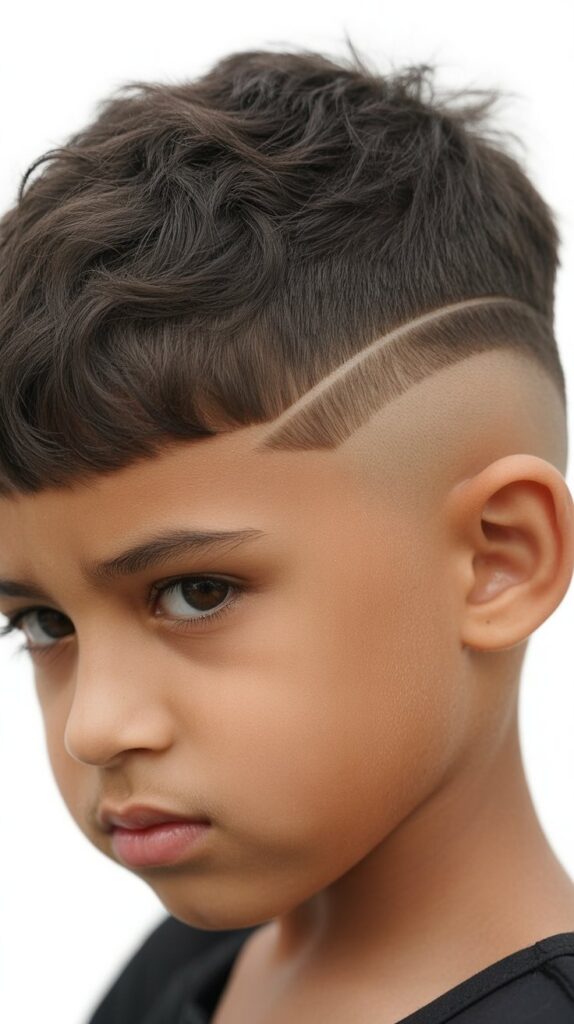
The combination style integrates multiple cutting and styling techniques into one cohesive haircut, addressing various concerns about fine straight hair through comprehensive approach.
This custom method allows stylists to create truly personalized results.
- This approach might combine elements like textured top, faded sides, tapered neckline, and shaped fringe all in one cut.
- The multi-technique method addresses fine hair’s challenges from every angle rather than relying on single solutions.
- Experienced stylists assess the specific baby’s hair pattern, face shape, and lifestyle to determine which techniques to combine.
- Common combinations include: textured crop with temple fade, side part with layered ends, or quiff with undercut.
- Fine straight hair benefits from this comprehensive approach because each technique compensates for the others’ limitations.
- These custom cuts typically cost more but deliver superior results tailored to individual needs.
- Parents should communicate clearly about their styling abilities and time constraints so stylists can create realistic combinations.
- The combination approach represents the pinnacle of modern children’s hair styling, showcasing technical skill and artistic vision.
34. Extra Bonus: First Haircut Special Consideration

The first haircut carries special emotional significance and requires particular considerations for babies with fine straight hair.
This milestone moment demands techniques that ensure positive experiences while achieving good results.
- First haircuts for fine-haired babies should prioritize minimal length removal to avoid shocking parents with how much thinner hair appears when very short.
- Many stylists recommend simple uniform trims or light shaping rather than dramatic style changes for first cuts.
- The sensory experience matters as much as the result—using quiet clippers, gentle movements, and patience builds positive associations.
- Fine baby hair often has uneven growth patterns that even out after the first cut, revealing true texture and density.
- Parents should save a small lock of hair from the first cut as a keepsake, acknowledging the emotional significance.
- Scheduling first haircuts when babies are well-rested and fed increases cooperation and reduces stress for everyone involved.
- Some babies’ fine hair doesn’t require cutting until 18-24 months, while others benefit from light trims around 12 months.
- Stylists experienced with babies understand how to work quickly and efficiently, completing cuts before attention spans expire.
Maintenance Tips for Fine Straight Hair
Maintaining fine straight hair between haircuts requires specific strategies that preserve hair health while maximizing appearance. These practical tips help parents keep their baby boys looking their best daily.
- Use sulfate-free baby shampoos that clean gently without stripping natural oils that fine hair desperately needs.
- Wash hair only 2-3 times per week unless necessary, as over-washing removes protective oils and makes fine hair limper.
- Pat hair dry with soft towels rather than rubbing vigorously, which can damage delicate fine hair strands.
- Invest in a soft-bristle baby brush that detangles without breaking or pulling out fragile hairs.
- Avoid heavy conditioning products that weigh down fine hair, making it appear flatter and thinner.
- If using styling products, choose lightweight formulas specifically designed for fine hair or babies.
- Protect hair from sun damage with hats during extended outdoor play, as fine hair shows UV damage more readily.
- Trim neckline and around ears between full haircuts to maintain neat appearance for 5-6 weeks instead of 3-4.
Choosing the Right Stylist
Finding a skilled stylist who understands the unique challenges of fine straight baby hair makes the difference between good and exceptional results. These selection criteria help parents make informed choices.
- Seek stylists or barbers with specific experience cutting children’s hair, particularly babies and toddlers.
- Ask potential stylists directly about their experience with fine hair textures and what techniques they use.
- Look for salons with child-friendly environments including special chairs, entertainment, and patient staff.
- Read online reviews specifically mentioning fine hair experiences to gauge stylist expertise with this texture.
- Schedule consultation appointments to meet stylists, observe their demeanor with children, and discuss options before committing.
- Experienced children’s stylists work quickly and efficiently, understanding that young children have limited patience.
- Don’t hesitate to try different stylists until finding one who consistently delivers results you love.
- Build a relationship with a trusted stylist who learns your child’s hair patterns and your family’s preferences over time.
Styling Products for Fine Baby Hair
- Always choose products specifically formulated for babies or with natural, gentle ingredients.
- Fine hair requires significantly less product than thick hair—start with pea-sized amounts.
- Water-based formulas wash out easily and don’t leave residue that weighs down delicate hair.
- Avoid products containing silicones, sulfates, or heavy oils that coat fine hair and make it appear greasy.
- Test new products on a small section first to ensure no irritation or allergic reactions occur.
- Many stylists recommend skipping products entirely for everyday wear, reserving them for special occasions only.
Common Mistakes to Avoid
Understanding common mistakes helps parents and stylists avoid choices that make fine straight hair look worse rather than better.
- Cutting too short everywhere: This often makes hair appear even thinner and can emphasize sparse areas rather than disguising them.
- Over-layering: Too many layers in fine hair can create a stringy, separated appearance rather than adding body.
- Using heavy products: Thick creams, oils, or waxes weigh down fine hair, eliminating any natural volume.
- Cutting when hair is dry: Fine hair should be cut damp or wet for precision, as dry cutting can create uneven results.
- Copying styles designed for thick hair: What works for dense hair often fails with fine textures; choose appropriate styles.
- Neglecting regular trims: Fine hair shows growth and shapelessness more quickly than thick hair requires more frequent maintenance.
- Over-washing: Stripping natural oils makes fine hair look limper and less healthy than washing 2-3 times weekly.
- Expecting product miracles: No product can transform genuinely thin hair into thick hair; work with what exists naturally.
Age-Appropriate Style Considerations
Different ages present unique considerations for fine straight hair, requiring adjusted approaches as babies grow into toddlers and beyond.
- 6-12 months: Many babies still have very sparse hair; minimal trimming to shape is usually sufficient rather than full cuts.
- 12-18 months: First real haircuts typically happen during this window; keep changes subtle and lengths manageable.
- 18-24 months: Hair has usually thickened slightly; more structured styles become possible and appropriate.
- 2-3 years: Toddlers can sit longer and express preferences; involve them in simple style choices when possible.
- Very young babies benefit from simpler, shorter cuts that don’t require daily styling or maintenance.
- As children approach preschool age, slightly more sophisticated styles become appropriate for developing social awareness.
- Consider the child’s activity level—highly active toddlers need practical cuts that stay out of eyes and off necks.
- Balance parental aesthetic preferences with the child’s comfort and the practical realities of their daily routine.
Seasonal Haircut Adjustments
Seasonal changes affect how fine straight hair behaves and what styles work best throughout the year.
Summer Considerations
- Shorter styles keep babies cooler during hot weather and reduce heat-related discomfort.
- Buzzed or crew cuts dry quickly after swimming and require minimal maintenance during active summer play.
- Fine hair shows sun damage more readily; shorter lengths mean damaged ends are quickly trimmed away.
- Lighter, shorter styles photograph beautifully in bright summer lighting conditions.
Winter Considerations
- Slightly longer styles provide extra warmth and protection for ears and neck during cold weather.
- Static electricity affects fine hair more dramatically in winter; longer styles show static less than very short cuts.
- Hats and winter accessories work better with moderate-length styles that don’t get completely flattened.
- Longer wispy styles create beautiful movement when photographed in winter lighting conditions.
Transition Seasons
- Spring and fall allow experimentation with moderate lengths that work for varying temperatures.
- These seasons provide good timing for growing out cuts or transitioning between summer and winter styles.
When Fine Hair Becomes Thicker
Many babies with fine straight hair eventually develop thicker, coarser hair as they mature, requiring adjusted cutting approaches.
- Most children experience hair texture changes between ages 2-4 as baby hair is replaced by more mature strands.
- Fine baby hair gradually sheds and is replaced by thicker, stronger hair with different characteristics.
- Parents often notice hair becoming coarser, easier to style, and requiring different cutting techniques.
- Styles that worked beautifully for fine hair may need adjustment as hair thickens and gains body.
- The transition period can create uneven texture as old and new hair coexist; be patient through this phase.
- Communicate with your stylist about observed changes so they can adjust techniques accordingly.
- Thickening hair opens up new style possibilities that weren’t achievable with very fine texture.
- Some children maintain fine hair into adulthood; others develop thick hair completely different from their baby texture.
Photography Tips for Fine-Haired Babies
Fine straight hair can look stunning in photographs when properly lit and positioned, maximizing appearance through smart photography techniques.
- Use natural diffused lighting from windows or outdoors rather than harsh direct light that emphasizes thinness.
- Position babies with light coming from slightly behind to create a glowing halo effect around fine hair.
- Avoid direct overhead lighting that casts shadows on the scalp, making sparse areas more visible.
- Photograph from slightly above rather than straight-on to give hair more visual presence in frames.
- Outdoor golden hour lighting (shortly after sunrise or before sunset) flatters fine hair beautifully.
- Use plain backgrounds that don’t compete with or overpower delicate hair appearance.
- Capture movement shots where hair is lifted by breeze, showing dimension rather than lying flat.
- Close-up detail shots of perfectly cut fine hair can be stunning when properly executed with right lighting.
Dealing with Cowlicks and Growth Patterns
Cowlicks and unusual growth patterns present particular challenges with fine straight hair, requiring strategic cutting approaches.
- Identify dominant cowlicks before cutting by observing how wet hair dries naturally without manipulation.
- Work with growth patterns rather than fighting them; styles that complement natural direction look better and last longer.
- Crown cowlicks often require leaving slightly more length to weight down the lifted area.
- Front hairline cowlicks can be incorporated into side parts or swept styles that disguise the swirl.
- Multiple cowlicks sometimes require combination approaches using different techniques in different areas.
- Very short cuts (buzzed or crew) eliminate cowlick visibility by keeping everything too short to stick up.
- Experienced stylists understand how to angle cuts to minimize cowlick impact on overall appearance.
- As hair grows and matures, some cowlicks become less prominent while others become more visible.
Budget-Friendly Maintenance Strategies
Professional haircuts can become expensive with frequent maintenance requirements, but smart strategies help families manage costs.
- Learn to do simple neckline cleanups and ear trims between full professional cuts, extending salon visits from 3 to 5-6 weeks.
- Invest in quality home hair cutting scissors and clippers for minor maintenance work.
- Many barber schools and cosmetology programs offer discounted cuts performed by supervised students.
- Some salons offer children’s haircut packages or memberships that reduce per-visit costs with commitment.
- Schedule haircuts strategically before major events (holidays, photos) rather than on rigid timelines.
- Simple uniform-length cuts cost less than complex fades and styled cuts at most establishments.
- Build relationships with stylists who may offer loyalty discounts or flexible pricing for regular customers.
- Watch online tutorials about basic baby haircut techniques for emergency trims or very simple maintenance.
Health Considerations for Fine Hair
Hair health directly impacts appearance, particularly with fine straight hair that shows damage and deficiency more readily than thick hair.
- Ensure proper nutrition including proteins, vitamins (especially biotin and vitamin D), and healthy fats that support hair growth.
- Address any underlying medical conditions that might affect hair thickness or growth patterns.
- Avoid tight hairstyles, headbands, or accessories that create tension on delicate fine hair follicles.
- Use gentle, baby-appropriate hair care products without harsh chemicals that could damage developing hair.
- Protect fine hair from excessive sun exposure, chlorine, and salt water that can cause brittleness.
- Be aware that some medications or health conditions can temporarily affect hair thickness and growth.
- Consult pediatricians if you notice sudden hair thinning, bald patches, or dramatic texture changes.
- Remember that fine hair is often genetic and normal rather than indicating any health problem.
Cultural and Regional Considerations
Different cultures and regions have varying preferences and traditions around baby boys’ haircuts that intersect with fine straight hair management.
- Some cultures prefer keeping baby boys’ hair longer until specific ages or ceremonies before first cuts.
- Regional climate significantly influences practical style choices—humid areas require different approaches than dry climates.
- Urban versus rural settings offer different stylist availability and exposure to contemporary trends.
- Certain religious or cultural traditions may dictate specific hair practices that need accommodation within style choices.
- Extended family expectations sometimes influence parents’ haircut decisions for young children.
- Social media has globalized style trends, making contemporary cuts available across geographic boundaries.
- Respect cultural preferences while educating about techniques that specifically help fine straight hair look its best.
- Experienced stylists can often adapt traditional cultural styles using modern techniques suitable for fine hair textures.
Conclusion
Navigating the world of Best 33+ Baby Boys’ Haircuts for Straight Fine Hair empowers parents with knowledge, confidence, and practical strategies for making their little ones look absolutely adorable.
Throughout this comprehensive guide, we’ve explored diverse options ranging from timeless classics like buzz cuts and side parts to contemporary styles including disconnected undercuts and textured quiffs, each specifically chosen for its ability to flatter and enhance fine straight hair textures.
The key to success lies in understanding your baby’s unique hair characteristics, choosing age-appropriate styles that match your family’s lifestyle, and working with experienced stylists who appreciate the nuances of cutting delicate hair.
Remember that fine straight hair possesses its own distinct beauty and advantages, including easier styling, faster drying, and natural shine that thicker textures often lack.
By selecting cuts that work with rather than against your baby’s natural hair texture, maintaining proper hair health through gentle products and appropriate washing frequency, and avoiding common mistakes that emphasize thinness, you’ll discover that fine hair can look just as stunning as any other texture.
Whether you prefer low-maintenance buzz cuts for active toddlers, sophisticated side parts for formal occasions, or trendy textured styles for fashion-forward families, the perfect haircut exists within these 33+ options to suit your baby boy’s personality, your parenting style, and the practical realities of daily life with young children.
